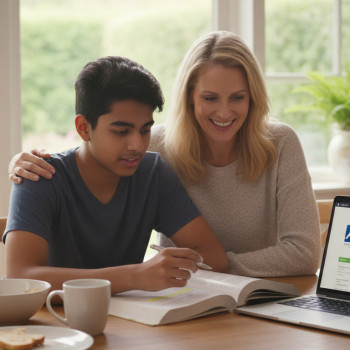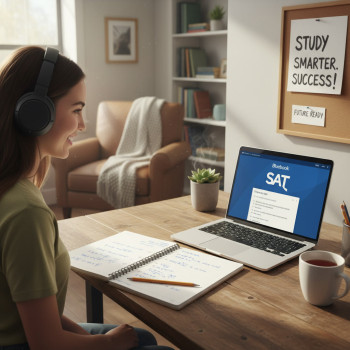Why Food Matters on SAT Day (and Why It’s Not About a Miracle Meal)
You’ve studied vocab lists, practiced math problems, and simulated test conditions. But there’s one quiet, powerful factor that can make the difference between a foggy morning and a sharp, focused test session: what you eat and drink before and during the SAT.
Let’s be clear — no single food will double your score. Nutrition won’t replace preparation. But the right foods can steady your blood sugar, support attention and memory, keep stomach nerves calm, and help you feel like your best self when you sit down at that digital testing screen. Think of food as the sidekick to your studying: subtle, loyal, and surprisingly influential.
Big Picture Principles: Simple Rules to Follow
Before we dive into menus and schedules, anchor these easy-to-remember principles. They’ll keep you from overthinking and help you choose foods that actually support cognition and calm.
- Stabilize blood sugar: Favor balanced meals with protein, healthy fats, and slow-release carbs so energy doesn’t spike and crash mid-test.
- Hydrate thoughtfully: Small, steady sips matter more than chugging a giant bottle at once.
- Avoid new or spicy foods: Test day is not the day for food experiments; stick to foods your body knows and likes.
- Practice on a mock test day: Try your planned breakfast and break snack during a full practice test to make sure it sits well.
- Plan for breaks: You’ll have at least one scheduled break — plan a quick, compact snack you can eat comfortably and cleanly.
Timing Is Everything: A Practical Timeline
When you eat can be as important as what you eat. Below is a simple timeline you can adapt to your test start time.
| Time before test | What to aim for | Why it helps |
|---|---|---|
| 2–3 hours | Balanced breakfast (protein + complex carb + small healthy fat) | Provides steady energy and avoids mid-test hunger or sluggishness |
| 30–60 minutes | Small snack if hungry; water; avoid heavy foods | Tops off energy without digestive load or drowsiness |
| Break (mid-test) | Compact, low-mess snack + water | Restores focus and prevents an afternoon slump |
Practical example
If your test begins at 8:30 a.m., aim to finish breakfast by 6:30–7:30 a.m., and bring a snack to eat at the scheduled break (for many digital test formats that’s around halfway through). If your commute is long, do a lighter breakfast earlier and pack the more substantial item to eat closer to test time after you’ve arrived and had a brief walk.
What to Eat for Breakfast: Smart, Calm, and Filling
Breakfast is your main event. You want something that promotes focus, steadies mood, and won’t leave you feeling heavy. Here are dependable patterns and concrete ideas.
Breakfast building blocks
- Protein: eggs, Greek yogurt, cottage cheese, nut butter, lean turkey — protein helps with alertness and satiety.
- Slow carbs: oats, whole-grain toast, quinoa, barley, or a whole-grain bagel — these release glucose gradually.
- Healthy fats: avocado, nuts, seeds — fats support brain function and keep you full longer.
- Fruit or vegetables: berries, banana, spinach or a little tomato — for vitamins, fiber, and gentle glucose.
Breakfast combos that actually work
- Oatmeal made with milk (or a milk alternative) stirred with Greek yogurt, a tablespoon of nut butter, and a few berries.
- Two scrambled eggs on whole-grain toast with half an avocado and a small apple.
- Greek yogurt parfait: plain or lightly sweetened Greek yogurt, granola (modest amount), and sliced banana.
- Whole-grain bagel with smoked turkey or nut butter + a side of mixed berries.
- Smoothie: spinach, frozen berries, a banana, Greek yogurt or protein powder, and a tablespoon of chia seeds — drinkable, balanced, and portable.
Tip: If you normally skip breakfast, don’t go cold turkey on test day. Have something small and familiar — even whole-grain toast with peanut butter — rather than trying a large new meal.
Snacks for the Test Break: Simple, Clean, and Quick
Most digital SAT administrations allow a short supervised break. What you eat during this time should be tidy, easy to eat, and designed to stabilize—not spike—your energy.
Best snack characteristics
- Small and portable — fits in a pocket or a small bag.
- Low-mess — no sticky or crumbly foods that could be distracting.
- Balanced — include a little protein or fat and a slow carb.
- Familiar — choose what you’ve tested during practice runs.
Great break snack ideas
- A small banana with a tablespoon of peanut or almond butter (the banana gives quick glucose; the nut butter stabilizes it).
- A homemade energy bite (oats, nut butter, a few chocolate chips, honey) — keep portions modest.
- A small container of Greek yogurt (if you can keep it cool) or a squeezable yogurt pouch.
- A handful of nuts and a few dried cranberries — not too many dried fruit pieces to avoid sugar spikes.
- A rice cake or whole-grain cracker with a slice of cheese or turkey.
Bring your snack in a simple, resealable bag so you can eat quickly and return to the test relaxed. And practice how long your snack needs to be eaten — you don’t want to rush or stay worrying about it.
Hydration: The Quiet MVP
Dehydration is a sneaky attention thief. Even mild dehydration can make you feel less alert. At the same time, too much water at once can be uncomfortable. Here’s a smart hydration strategy.
- Start hydrating the evening before: a steady, adequate intake helps sleep quality and morning alertness.
- Have 12–16 ounces of water with breakfast (not a huge gulp, but enough to feel comfortable).
- Carry a small water bottle to sip before the test and during the break; avoid chugging immediately before sitting back down.
- Avoid excessive caffeine — a small cup of coffee or tea may help some students, but too much raises anxiety and can disrupt thinking for others.
Foods to Avoid (and Why)
Some foods are more likely to backfire on test day. Avoid them, especially if you’re trying something new or know you’re sensitive to it.
- Greasy, heavy meals: Big breakfasts of fried foods can slow you down and make you sleepy.
- Large amounts of refined sugar: Candy or a big pastry can spike then crash blood sugar.
- New or exotic foods: Anything that might cause stomach upset or an allergic reaction is a no-go.
- Too much caffeine: Nervousness, heart-racing, or the need for frequent restroom breaks hurt long-form attention.
- Excessive fiber right before the test: While fiber is great generally, a very high-fiber meal right before the exam might increase bathroom urgency for some students.
Special Cases: Food Considerations for Common Test-Day Concerns
If you get nervous stomachs
Choose bland, familiar foods: plain toast, a banana, applesauce, or a small portion of plain yogurt. Ginger tea (if you tolerate it) can help calm nausea; avoid fizzy drinks that can cause bloating.
If you’re prone to afternoon energy slumps
Emphasize protein and healthy fats in breakfast (e.g., eggs + avocado or Greek yogurt + nuts) to provide sustained energy. On the break, include a bit of protein to avoid a sugar crash.
If you have diabetes or other metabolic concerns
Follow your prescribed medical plan and communicate with the test center staff in advance if you need accommodations for medications, snacks, or glucose monitoring. Practice your timing during full-lengths to know how your glucose responds to different foods.
Sample Menus: Pick One That Fits Your Routine
These menus are built around the timing rules above. Choose one you can replicate during full practice tests so you know how it affects your body and brain.
Menu A — The Classic Balanced
- Breakfast: Two eggs (scrambled or boiled), whole-grain toast, half an avocado, and a small orange.
- Break snack: Banana + 1 tablespoon peanut butter.
- Hydration: 12 oz water at breakfast; small sips during break.
Menu B — The Light and Drinkable
- Breakfast: Smoothie with spinach, frozen berries, Greek yogurt, banana, and a tablespoon flax or chia seeds.
- Break snack: Handful of mixed nuts and 3–4 dried apricots.
- Hydration: 12 oz water plus a small decaf tea if you like.
Menu C — The Grain-forward Option
- Breakfast: Oatmeal made with milk, stirred with a scoop of Greek yogurt or protein powder, topped with almonds and blueberries.
- Break snack: Plain rice cake with a smear of nut butter and a few slices of apple.
- Hydration: 12 oz water and light sips as needed.
Real-World Tips: Logistics, Packing, and Practice
It’s the little details that make test day feel calm instead of chaotic. Here are practical logistics to reduce stress.
- Pack the night before: breakfast if you’ll eat on the go, your break snack, a small water bottle, and any needed medications.
- Use resealable containers and napkins: keep it tidy in the test room and reduce crumbs that bother you later.
- Wear layers: comfort affects digestion and stress; a light sweater can help regulate body temperature if you’re nervous.
- Practice with your menu: eat the same breakfast during one or two full practice tests so you know how you’ll feel.
- If you’re using a portable device or school-managed computer, follow the College Board guidelines about what you can bring for breaks to avoid surprises.
Mindset Food: Using Nutrition to Reduce Anxiety
Food can also be part of your mental routine. Rituals around eating — a consistent breakfast, a small snack you always bring, a favorite mug for tea — become anchors on a stressful day. They signal to your brain: this is familiar, this is the plan, you’ve prepared for this.
Another small trick: breathe for 60 seconds before you eat. It slows your heart rate, primes digestion, and can reduce the fight-or-flight feeling that sometimes shows up before big tests.
When to Get Medical Advice or Accommodations
If you have known allergies, chronic digestive conditions, diabetes, or take medications that interact with food or glucose, plan ahead. Communicate with school staff or the testing organization about necessary accommodations. For students with documented needs, it’s perfectly reasonable and often necessary to request permission to bring certain foods or medical supplies into the testing room.
How Sparkl’s Personalization Can Help (When It Fits Naturally)
Nutrition is personal: what keeps one student calm might make another jittery. That’s where personalized tutoring and coaching can help. Sparkl’s 1-on-1 guidance and tailored study plans can include test-day routines — and for students who want deeper support, Sparkl’s expert tutors and AI-driven insights can help you experiment with breakfast and snack choices during simulated tests so you arrive at a customized, confidence-building plan.
Quick Checklist You Can Print or Screenshot
Use this as a rapid pre-test review the night before and the morning of the SAT.
- Pack: breakfast or breakfast-to-go, snack for break, water bottle, medication (if needed).
- Practice: ate this breakfast during a full-length practice test at least once.
- Sleep: aim for consistent sleep the nights leading up to the test.
- Hydrate: steady intake the day before and the morning of the test.
- Arrival: leave time for a brief walk to clear your head before the exam begins.
Common Myths, Busted
- Myth: Coffee will always help. Truth: A small amount may sharpen focus for some, but too much can increase anxiety. Know your tolerance.
- Myth: Heavy breakfasts make you more energized. Truth: Too heavy a meal can make you sluggish and uncomfortable during thinking tasks.
- Myth: Sugary snacks give long-lasting energy. Truth: They can lead to quick spikes and crashes; pair them with protein or fat if you choose them.
Final Thoughts: Keep It Simple, Plan, and Practice
Test day is about performance under pressure, and your nutrition strategy should reduce pressure, not add to it. Choose familiar foods, aim for balance, hydrate steadily, and practice your plan during at least one full practice test. When you combine solid preparation with a calm, sensible eating strategy, you give yourself a real advantage: the clarity and endurance to show the work you’ve put in.
Good luck. Eat well, breathe, and trust your preparation. If you’d like help turning this advice into a personalized test-day plan (including practice runs with nutrition and pacing), Sparkl’s tutors can work with you one-on-one to craft a routine that feels right for your body and your schedule.
Note
This article offers general guidance intended to support students. If you have medical conditions or dietary restrictions, consult a healthcare professional for personalized advice.












No Comments
Leave a comment Cancel